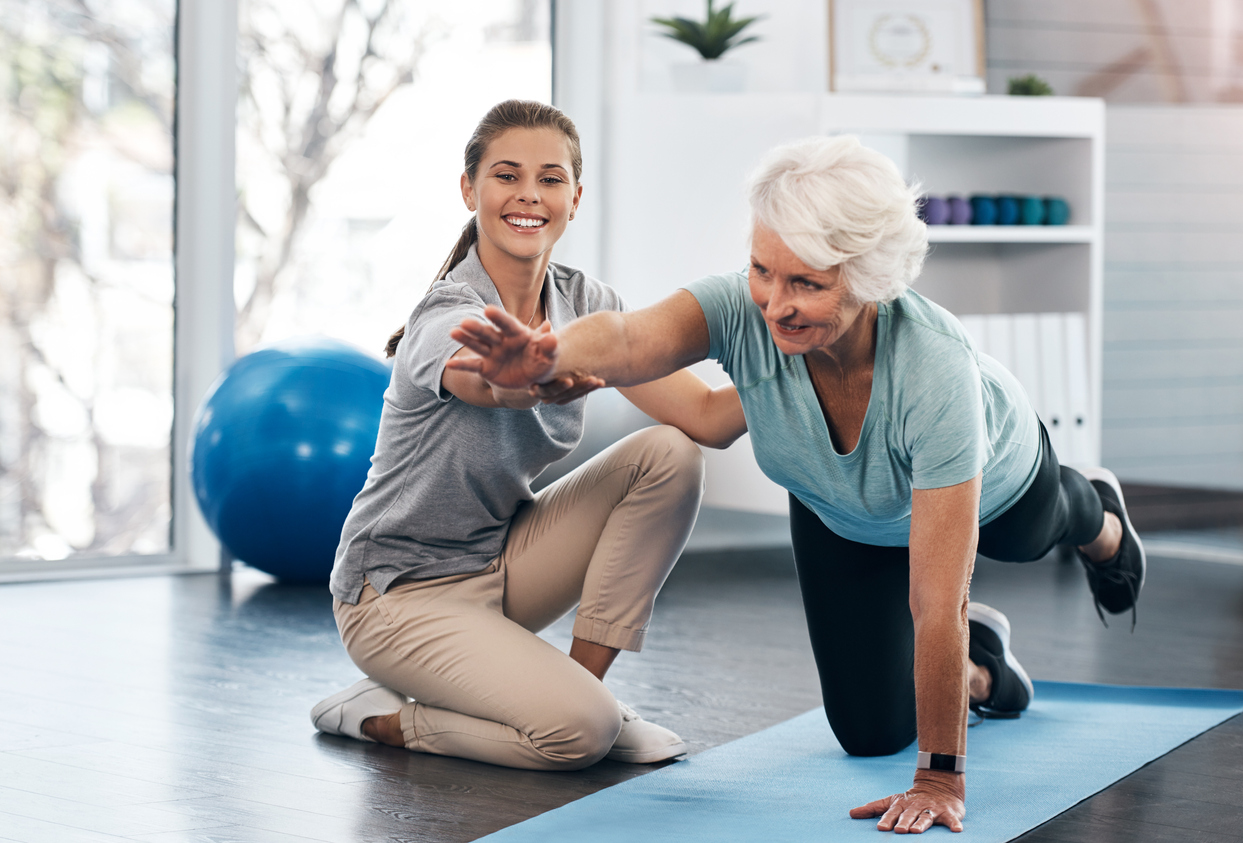Therapeutic exercise is defined as movement that is prescribed to rectify deficiencies, restore muscle and skeletal function, and maintain a healthy state of mind. The scientific data establishing the positive effects of exercise is undeniable, and in most adults, the benefits considerably outweigh the hazards. To enhance and maintain physical fitness and health, most adults require an exercise regimen that includes aerobic, resistance, flexibility, and neuromata exercise training.
Therapeutic exercise is a foundational skill in the physiotherapy at home profession. What is the difference between exercise and physical activity?
- Physical activity is the contraction of skeletal muscle that results in body movement and energy expenditure.
- Exercise is a planned and executed physical activity to improve or maintain physical fitness. Physical fitness is a set of characteristics that enable a person to engage in physical exercise.
The following are some examples of therapeutic exercise:
- Conditioning and reconditioning of the aerobic and endurance systems
- Agility training;
- Body mechanics training;
- Breathing exercises;
- Coordination exercises;
- Training in developmental activities;
- Neuromuscular education or reeducation;
- Movement pattern training;
- Neuromotor development activities training;
- Perceptual training;
- Soft tissue stretching and range of motion exercises;
- Relaxation activities;
- Strength, power, and endurance workouts
There are four types of workouts that are frequently included.
- Strengthening exercises are usually done with much resistance and fewer reps.
- Endurance workouts that activate big muscle groups for a more extended time, aiming for a VO2Max of 50 to 60% to improve cardiovascular endurance.
- Stretching and movement activities to increase flexibility.
- Balance and coordination exercises emphasize keeping one’s center of gravity in check.
All of these can be combined into workout routines that benefit various patients. Different subtypes of workouts can aid in increasing efficacy or allowing those with comorbidities to participate. Aquatic treatment, for example, can help stroke patients with trouble with their balance.
The FITT mnemonic should be used in essential exercise prescriptions.
- F- Frequency refers to the number of days in a week.
- Intensity: mild, moderate, or strong
- TIME FOR EXERCISE: MINUTES PER SESSION FOR EXERCISE OF END
- T-Type: endurance, strength, flexibility, or a combination of these factors.
Exercises to Build Endurance
The FITT factors, which are Frequency, Intensity, Time, and Type of activity, can be used to describe the exercise dose.
The frequency is the number of times something happens (how often)
Exercise should be done 3-5 times per week.
Training three times per week delivers significant effects; however, for some persons, training five times per week at a reduced intensity may be more manageable. With more than five training sessions each week, there is a small additional benefit, but the danger of injury increases. Although training twice a week does not result in increased VO2max, it may result in some functional changes and is probably preferable to no exercise.
Most individuals should engage in moderate-intensity aerobic exercise for at least five days per week, vigorous-intensity aerobic exercise for at least three days per week, or a weekly combination of 3–5 days per week of moderate and vigorous-intensity exercise to attain and maintain health/fitness advantages.
The level of difficulty (how hard)
The rate at which an activity is conducted or the amount of effort necessary to execute an action or exercise is called intensity. It can be described as “how hard a person works to complete an activity.” In most people, heart rate can be used to measure exercise intensity; however, certain patients may have pathology or be on medication that alters their HR response to exercise. HR cannot be used to assess exercise intensity. There are three primary levels of intensity when it comes to exercise. Low, moderate, and vigorous are the three levels.
The overload principle implies that exercise below a certain intensity, or threshold, will not sufficiently challenge the body to cause changes in physiologic parameters, such as increased maximal oxygen consumption per unit of time (VO2max).
The following computation can compute an individual’s training HR band using the Karvonen approach, which takes resting into account. A formula for calculating the training heart rate, which is equal to the target VO2max %. It includes multiplying the resting heart rate by a percentage of the maximal heart rate reserve (maximal heart rate—resting heart rate). The maximum heart rate is typically thought to be 220—years of age.
As a result, for a work rate comparable to 75 percent VO2max, the following equation is used to compute the training heart rate: training heart rate = 0.75 max HRR + resting HR; where max HRR is the Maximum Heart Rate Reserve and resting HR is the resting Heart Rate. A training target heart rate range is typically set between 50 and 85 percent of VO2max, i.e., 0.50 max HRR + resting HR to 0.85 max HRR + resting HR.
Without a heart rate monitor, folks can check their pulse to ensure they’re working at the appropriate intensity. Patients should be taught to take their carotid pulse within the first 10 or 15 seconds of stopping exercise and multiply the counted pulses by 6 or 4 to get beats per minute. The oxygen uptake reserve can also be utilized to determine exercise intensity, with a range of 40-50 percent to 85 percent being advised.
The prescribed exercise intensity can be modulated or refined using measures of perceived effort and affective valence (i.e., how enjoyable exercise is). The Borg Rating of Perceived Exertion (RPE) Scales, OMNI Scales, Talk Test, and Feeling Scale is among these measurements.
Walking is the most popular kind of endurance exercise, and it is the one that doctors most usually recommend. Walking is simple to add to one’s everyday routine. According to one study, seniors who walk at least 2 kilometers daily reduce their mortality risk by 50%. Swimming, cycling, dancing, and walking upstairs instead of taking the elevator are excellent endurance training, as are golf (walking), gardening or heavy yard work, and low-impact aerobics.
The passage of time (duration or how long)
Daily aerobic activity should be 20-60 minutes of continuous or intermittent activity. The activity can be divided throughout the day into a minimum of lO-minute bouts. The length of time spent training is determined by the intensity. Individuals who begin at the lower end of the training spectrum must exercise for more extended periods (30-60 minutes) to obtain training effects.
Type
To enhance health and CRF, all individuals should engage in a cyclic, aerobic activity of at least moderate intensity that utilizes vast muscle groups and requires minimal technique. Other exercises and sports requiring skill or greater fitness levels are only recommended for people with the necessary skill and fitness to participate.
Exercises for Strengthening
Strength training is a type of exercise that involves resistance training and is used to strengthen muscle tissue. Strength training can be done at a high or low intensity.
Isotonic, isometric, and isokinetic are three types of this technique that build total strength.
- Isotonic movements are those that involve dynamic movements with a constant load.
- In isokinetic, a constant velocity is combined with a variable load.
- Isometric contractions include a static muscle contraction with no change in muscle length.
Resistance training (RT) has been proven to improve muscle strength, power, and hypertrophy, all of which are essential aspects of physical fitness that affect the quality of life. To increase strength, traditional resistance training recommendations prescribe a 60–70% one-repetition maximum (1 RM) intensity for inexperienced exercisers.
Loads below 60% 1RM, on the other hand, might cause significant strength increases in older healthy persons when compared to no training. Individual health and physical fitness goals should be met through exercise training programs tailored to the individual’s health state, function, and physical and social surroundings.
The goals of a health-related resistance training program for adults of all ages should be to (a) make activities of daily living (ADL) less stressful physiologically (e.g., stair climbing, carrying bags of groceries) and (b) effectively manage, attenuate, and even prevent chronic diseases and health conditions like osteoporosis, Type 2 diabetes mellitus, and obesity. As a result, while resistance training benefits people of all ages, it gets even more so as they get older.
The following is a statement from Royal Premiere Healthcare Center:
Millions of people suffer from low back pain. Stiffness, soreness, and limited mobility can negatively impact one’s quality of life. On the other side, maintaining a healthy weight and staying active may help you avoid lower back pain. If your back pain persists or prohibits you from doing the things you enjoy, you can contact an on call doctor Dubai. A variety of therapies can help you reduce pain, increase mobility, and get more out of life.











Leave a Reply